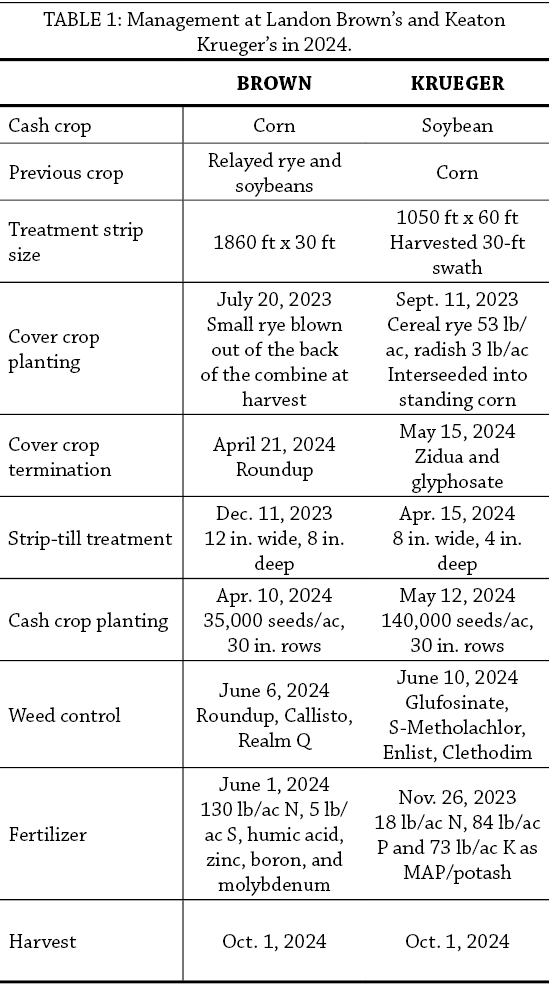This research was funded by Cargill and USDA-NRCS.
In a Nutshell:
- Many farmers use strip-till or no-till methods to plant corn and soybean crops because they want to reduce soil disturbance, minimize planting costs and/or plant green into standing cover crops.
- Strip-till requires an extra equipment pass compared to no-till but may result in higher yields. However, four out of five past PFI research trials directly comparing the two practices have shown no difference in corn and soybean yields between strip-till and no-till.
- This year, Iowa farmers Landon Brown and Keaton Krueger investigated how strip-till vs. no-till planting corn (Brown) and soybeans (Krueger) affected their crop yields.
Key Findings
- Krueger found that his strip-till soybeans outyielded his no-till soybeans by three bu/ac. This led to an increased net profit of about $14/ac in his strip-till soybeans after accounting for the cost of tillage.
- Brown found no significant difference in corn yield between his strip-till and no-till planted corn. Due to the cost of strip tillage, net profit of his strip-till corn was $22/ac less than his no-till corn.
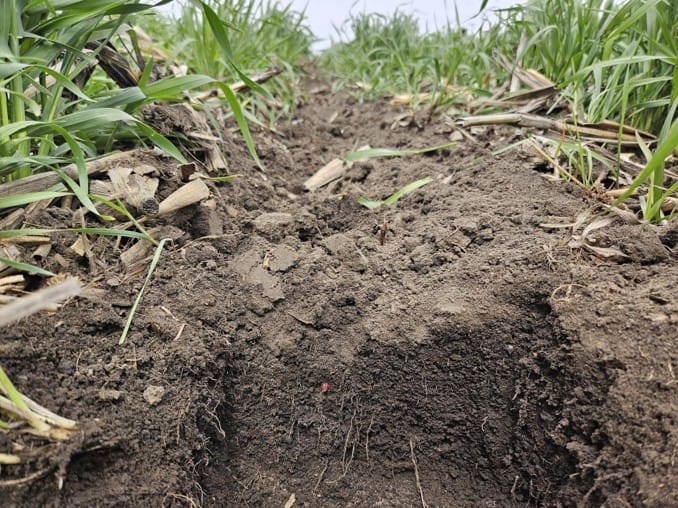
Close-up of a strip-tilled row between undisturbed cereal rye cover crop in Landon Brown’s field prior to corn planting. The hole visible in the foreground shows soil disturbance due to tillage and rye cover crop roots. Photo taken April 2024.
Background
No-till planting is a popular conservation practice that reduces soil erosion, improves soil quality and eliminates the labor and fuel costs of tillage. According to the US National Agricultural Statistics Service, no-till practices were used on more than a quarter of the US’s total cropland acres in 2022, including on 8.4 million acres in Iowa [1]. One drawback of no-till management is that in some conditions, it can cause modest yield declines compared to conventional tillage, especially when it is first implemented. One 2015 review of academic research found that in temperate climates like Iowa, no-till management on average results in a 3.4% yield decline compared to conventional tillage across all crops considered as a whole [2].
While some farmers find that yield decline in no-till acres is financially offset by the reduced management costs and long-term soil health benefits it conveys, others seek to limit yield losses by using alternative conservation tillage practices including strip tillage. Strip tillage involves tilling a narrow band of soil in each row into which a cash crop is planted. One recent review of academic studies shows that globally on average, strip-till produces 5% higher yields than no-till [3]. However, past research conducted by PFI farmers in 2018 and 2023 found that, at least in Iowa, strip tillage does not significantly increase yields compared to no-till in all years and conditions. Only one of the three past trials investigating corn yields found greater yields and economic returns in strip-till compared to no-till corn, and two trials in soybeans found no difference in yield between the two planting methods [4], [5]. Similarly, research done by Iowa State University has shown that strip-till did not increase corn or soybean yield compared to no-till in most trial years [6], [7], [8]. Because strip-till requires an additional tillage pass and additional equipment compared to no-till, farmers may find that strip tillage does not make financial sense for their farms if it does not provide a significant yield boost in most years.
Landon Brown and Keaton Krueger have both previously tried using strip-till instead of no-till in the hopes of seeing a yield boost that covers the cost of the extra tillage pass. This year, they decided to conduct replicated trials to rigorously test whether the two planting methods resulted in yield differences in their corn (Brown) and soybeans (Krueger). Brown reports that he has anecdotally seen no economic benefit from strip tillage in the past on his farm. Depending on the results of this trial, he “might quit doing strip-till to save money, time and fuel.” In a trial in 2023, Krueger found that strip-till soybeans on his farm yielded the same as no-till soybeans despite the strip-till beans looking better and having a higher stand count. He reports that “if I find no difference between strip-till and no-till again, I will likely abandon testing strip-till and just no-till my soybeans.”
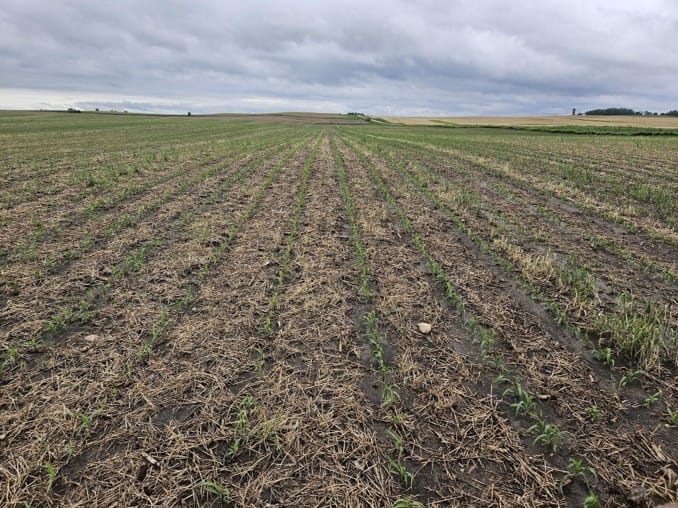
Landon Brown’s field experiment after corn emergence and cover crop termination. A no-till replicate is pictured on the left and a strip-till replicate is pictured on the right side of the photo, with more bare soil immediately under the corn plants. Photo taken early May 2024.
Methods
Design
Both Brown and Krueger planted strip-till and no-till treatments of their cash crops in 2024. Brown planted corn following relayed rye and soybeans and a cereal rye cover crop. Kreuger planted corn following soybean and a cereal rye and radish cover crop. Planting details and field management at both farms are presented in Table 1. Cooperators established treatments in randomized, paired strips: 2 treatments × 4 replications = 8 strips total.
Measurements
Both Brown and Krueger recorded grain yield and moisture using a yield monitor or weigh wagon. Reported soybean yields are corrected to 13% moisture and corn yields are corrected to 15.5% moisture. The cooperators also documented costs of equipment passes and applied products.
Data analysis
To evaluate the effect of treatment on soybean or corn yield and moisture, we calculated Tukey’s Honest Significant Difference (HSD) using a two-way ANOVA that accounts for treatment and replicate location at the 95% confidence level. If the difference in metric between the two treatments was greater than the HSD, we would expect such a difference to occur 95 times out of 100 under the same conditions – we refer to this as a statistically significant effect. On the other hand, if the resulting difference between the two treatments was less than the HSD, we would consider the results to be statistically similar. Note that a single HSD value is not available for Brown’s results because he had a different number of strip-till and no-till treatments. We could make these statistical calculations because both Brown’s and Krueger’s experimental designs involved replication and randomization of their treatments (Figure A1).
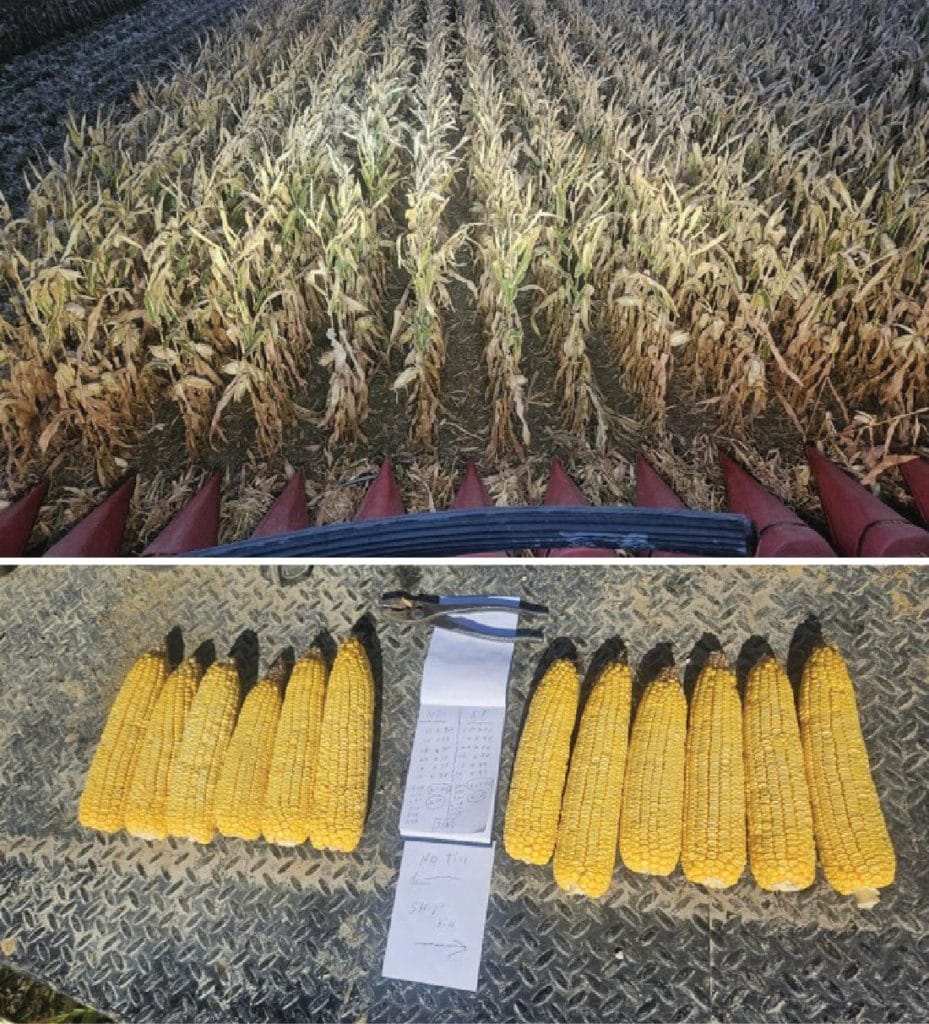
At harvest, Landon Brown reported that he could not visually tell where his no-till and strip-till treatments started and stopped (top). However, corn ear size appeared more variable in the no-till vs. strip-till treatments (bottom). Photos taken Oct. 1, 2024.
Results and Discussion
Brown found no statistically significant difference in yield between his strip-till and no-till corn (Figure 1). Because he estimates that he spent $22/ac on strip tillage, his net return on the strip-till corn was $22/ac less than his net return on the no-till corn. Brown reports that he has been informally trialing strip-till vs. no-till since he switched to no-till in 2016, he has never found that strip tillage is economically worth it. Even though he routinely observes about a 5-6 bu/ac yield advantage for strip-till, that is not an economic advantage once he accounts for the costs of fuel, time spent tilling and the cost of owning a strip-till bar.
Early in the season, Brown observed some differences in ground and corn plant condition between his no-till and strip-till treatments. Prior to corn establishment, there was erosion and wash-out of the tilled strips on the rolling hillslopes of his field. As farmers often report, the strip-till corn looked a bit better than the no-till corn prior to maturity. However, by harvest, there were no visible differences in the corn plants between treatments, though corn ear size appeared to be more variable in the no-till treatments (see photos above).
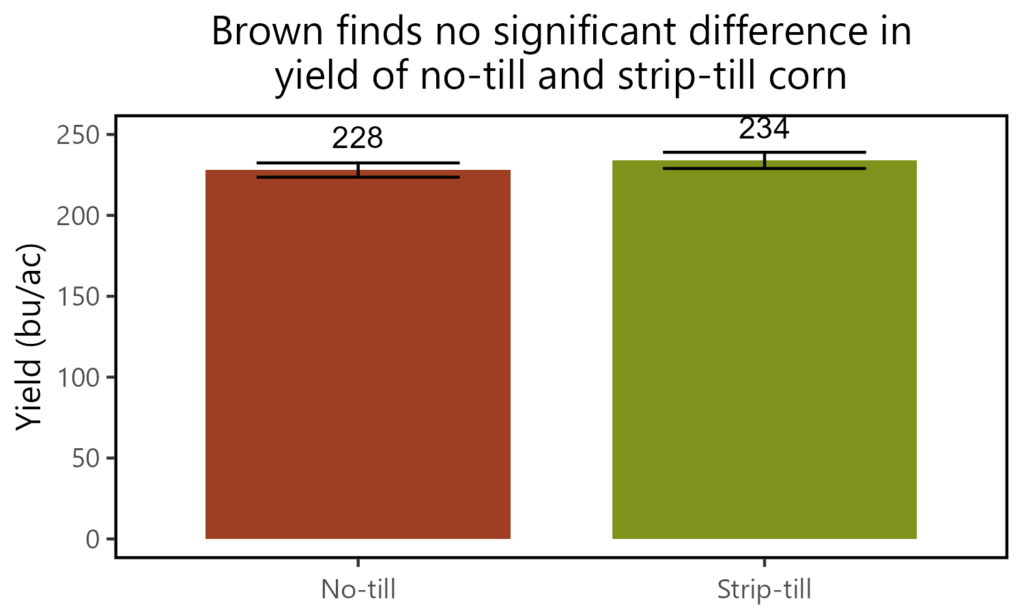
Figure 1. Corn yield in Landon Brown’s strip-till vs. no-till trial in 2024. Vertical lines on each bar show the standard deviation (SD). SD is a measure of how much the yields measured in each replicate are spread out from their mean. While it may appear from the mean values that Brown’s strip-till and no-till corn yields were quite different, his replicate yields within each treatment varied a lot from their mean value. This variability means that there was a lot of overlap in yields of his strip-till and no-till corn. We conclude that strip-till did not affect corn yield at the 95% confidence level.
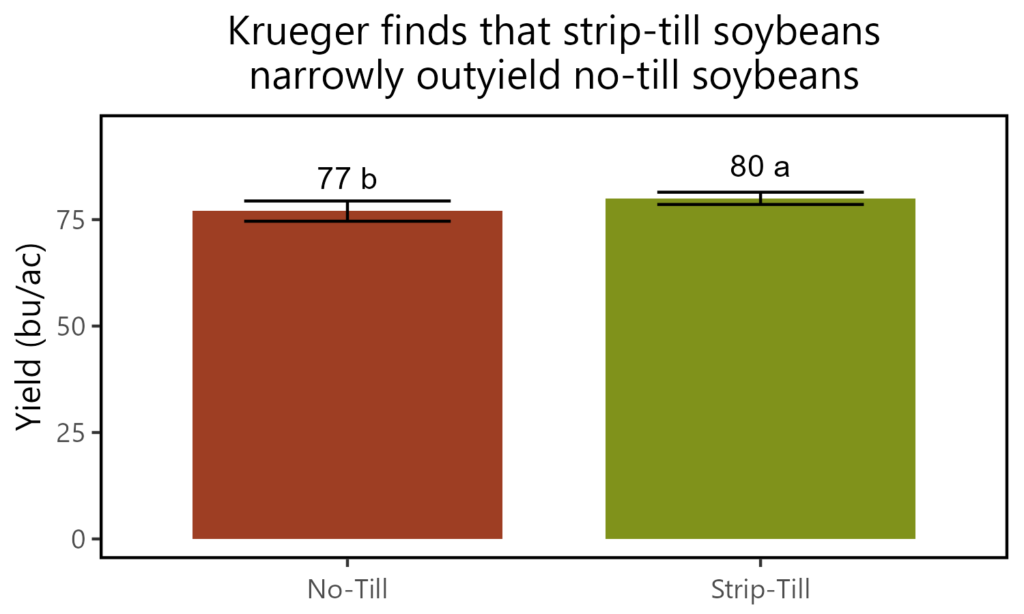
Figure 2. Soybean yield in Keaton Krueger’s strip-till vs. no-till trial in 2024. Vertical lines on each bar show the standard deviation (SD), which is a measure of how much the yields measured in each replicate are spread out from their mean. Unlike Brown’s corn yield, Krueger had very little variability in yield within his strip-till and no-till treatments. Measured yields show only a little overlap of his strip-till and no-till yield values, and statistical analysis showed that with 95% confidence, strip-tillage increased soybean yield compared to no-till (HSD = 3 bu/ac). Different letters above bars indicate significantly different yields.
In contrast to Brown’s results, Krueger found that his strip-till soybeans narrowly but significantly outyielded his no-till soybeans by 3 bu/ac in 2024 (Figure 2). He estimates that his strip-till pass cost $20/ac. Since he sold the soybeans for $10.25/bu, his return on investment in the strip-till treatment was $13.83/ac.
Krueger reflected that this year’s trial builds on his previous research into strip-tilling soybeans on his farm. In 2023, he conducted the same trial and found that while soybean stand count was lower in his no-till treatment, there was no difference in yield between the strip-till and no-till treatments. “This is the second year I have done a strip-till vs. no-till soybean trial. The first year, the results were not strong enough for me to draw a conclusion and the yield results did not match my observation in the field. Now that I have done the trial a second year, I feel more confident in adopting strip tillage.”
Conclusions and Next Steps
After finding that strip-till corn resulted in no significant yield increase and decreased net profits compared to no-till corn in 2024, Brown thinks that in the future, he will stick to no-till planting on his farm. Krueger, in contrast, found that his strip-tilled soybeans yielded higher and had a higher net profit than his no-till soybeans. He shared that “I think my default will be strip-till for 2025. If I decide to do the trial one more time, that will help me be really confident.” Brown and Krueger’s differing results and conclusions highlight the fact that strip tillage may be an economically valuable reduced-tillage method for some farms but will likely not be economically worth it depending on the crop grown, commodity price received, field and weather conditions and tillage and labor costs of each farm and farming year.
Appendix – Trial Design and Weather Conditions
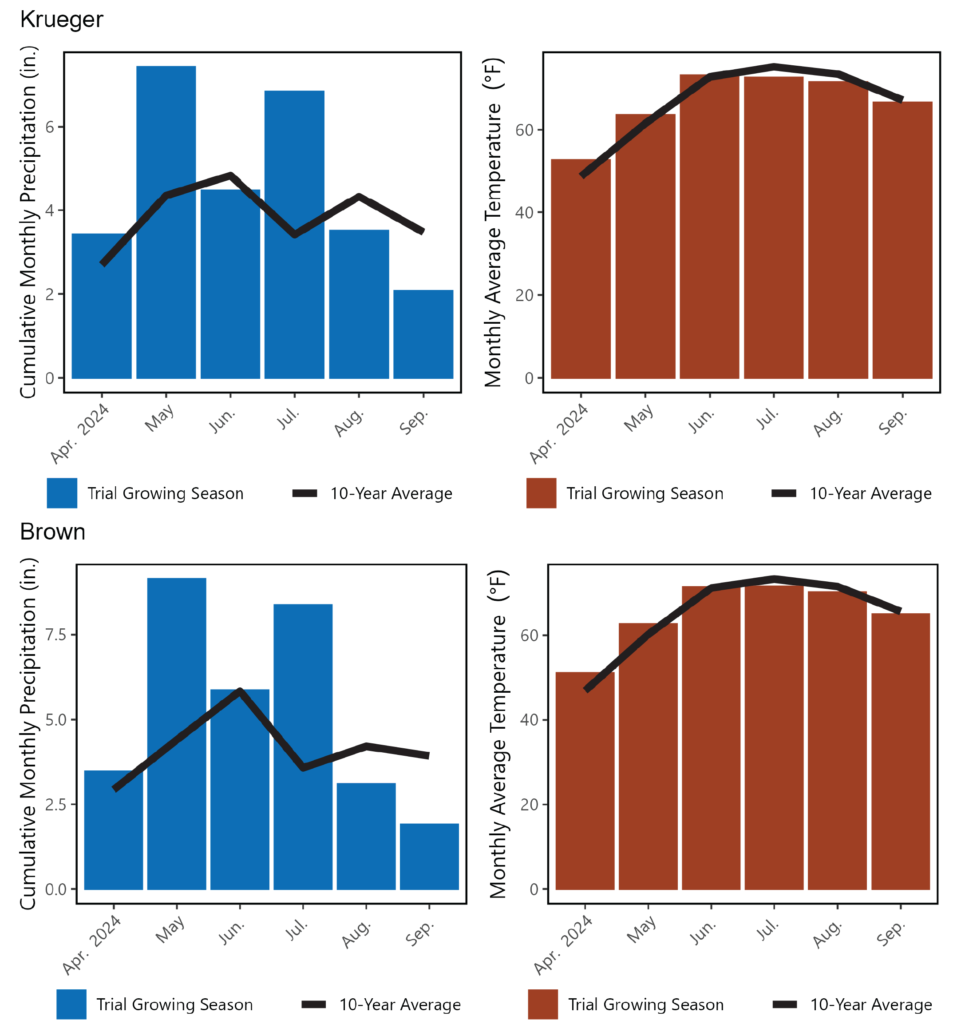
Figure A2. Monthly precipitation accumulation (left) and mean temperature (right) at New Providence, IA (Brown) and Ogden, IA (Krueger). [9]
Acknowledgements
This material is based upon work supported by the U.S. Department of Agriculture, under agreement number NR226114XXXXG004. Any opinions, findings, conclusions, or recommendations expressed in this publication are those of the author(s) and do not necessarily reflect the views of the U.S. Department of Agriculture. In addition, any reference to specific brands or types of products or services does not constitute or imply an endorsement by the U.S. Department of Agriculture for those products or services.
References
[1] T. Vilsack, “2022 Census of Agriculture United States Summary and State Data,” United States Department of Agriculture National Agriculture Statistics Service, AC-22-A-51, Feb. 2024. [Online]. Available: https://www.nass.usda.gov/Publications/AgCensus/2022/index.php
[2] C. M. Pittelkow et al., “When does no-till yield more? A global meta-analysis,” Field Crops Research, vol. 183, pp. 156–168, Nov. 2015, doi: 10.1016/j.fcr.2015.07.020.
[3] S. Dou et al., “Strip tillage promotes crop yield in comparison with no tillage based on a meta-analysis,” Soil and Tillage Research, vol. 240, p. 106085, Aug. 2024, doi: 10.1016/j.still.2024.106085.
[4] S. Gailans, J. Boyer, T. Sieren, and J. Gustafson, “No-till vs. Strip-till Corn and Soybeans Following a Cereal Rye Cover Crop,” Practical Farmers of Iowa, 2018. [Online]. Available: https://practicalfarmers.org/wp-content/uploads/2019/04/18.FC_.CC.No-vs.-strip-till-following-a-cover-crop.pdf
[5] K. Krueger, T. Sieren, and E. Link, “Strip-Till Vs. No-TIll Soybeans and Corn Following A Cover Crop,” Practical Farmers of Iowa, Research Report, 2023. [Online]. Available: https://practicalfarmers.org/wp-content/uploads/2024/06/23.FC_.striptill-vs-notill-1.pdf
[6] M. Al-Kaisi and M. A. Licht, “Effect of Strip Tillage on Corn Nitrogen Uptake and Residual Soil Nitrate Accumulation Compared with No-Tillage and Chisel Plow,” Agronomy Journal, vol. 96, no. 4, pp. 1164–1171, 2004, doi: 10.2134/agronj2004.1164.
[7] M. A. Licht, Z. A. Koopman, and K. R. Berns, “No-tillage, Strip-tillage, and Chisel Plow Tillage Trial,” Iowa State University, Digital Repository, Ames, 4142686, 2013. doi: 10.31274/farmprogressreports-180814-1815.
[8] M. Perez-Bidegain, R. M. Cruse, and A. J. Ciha, “Strip Till, No-Till and Conventional Tillage Comparisons – Does Planting Date Affect Results?,” in Proceedings of the Integrated Crop Management Conference, Iowa State University, Digital Press, Dec. 2003, p. 11977502. doi: 10.31274/icm-180809-761.
[9] A. H. Sparks, “nasapower: A NASA POWER Global Meteorology, Surface Solar Energy and Climatology Data Client for R,” Journal of Open Source Software, vol. 3, no. 30, p. 1035, Oct. 2018, doi: 10.21105/joss.01035.


